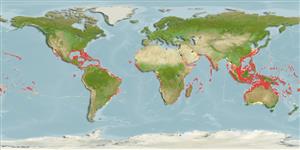Classification / Names
Common names from other countries
Main reference
Size / Weight / Age
Max length : 910 cm WD male/unsexed; (Ref. 58048); common length : 450 cm WD male/unsexed; (Ref. 3176); max. published weight: 3.0 t (Ref. 5377); max. reported age: 20 years (Ref. 31742)
Length at first maturity
Lm ?, range 380 - 460 cm
Environment
Marine; reef-associated; oceanodromous (Ref. 51243); depth range 0 - 120 m (Ref. 58302)
Climate / Range
Subtropical, preferred ?; 31°N - 35°S, 180°W - 180°E (Ref. 55255)
Distribution
Circumglobal, tropical to temperate: in the Northern Hemisphere, as far north as southern California and Rhode Island on the United States west and east coasts, Mutsu Bay, Aomori, Japan, the Sinai Peninsula, Egypt and the Azores Islands; in the Southern Hemisphere, as far south as Peru, Uruguay, South Africa and New Zealand. In
some locations, including Mozambique, it is sympatric with Manta alfredi.
Countries | FAO areas | Ecosystems | Occurrences | Introductions
Short description
A giant ray having an extremely broad head with long head fins, and a terminal mouth; upper surface of disc covered with denticles, and tail usually without a spine (Ref. 5578). Blackish above, sometimes with white shoulder patches; white below, with grey edging on disc (Ref. 5578). Tail whiplike but short (Ref. 7251).
IUCN Red List Status (Ref. 115185)
Human uses
Fisheries: minor commercial
More information
ReferencesAquacultureAquaculture profileStrainsGeneticsAllele frequenciesHeritabilityDiseasesProcessingMass conversion
Tools
Special reports
Download XML
Internet sources
Estimates of some properties based on models
Phylogenetic diversity index
PD50 = 0.7500 many relatives (e.g. carps) 0.5 - 2.0 few relatives (e.g. lungfishes)
Trophic Level
3.5 ±0.50 se; Based on food items.
Resilience
Very Low, minimum population doubling time more than 14 years (tm=6; tmax=20; Fec=2)
Vulnerability
Very high vulnerability (78 of 100)
Price category
